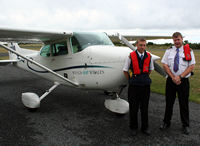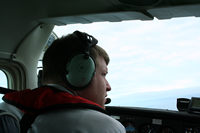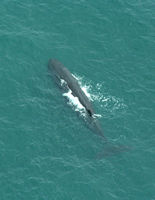|
Whale
Watching in Kaikoura
Book
Kaikoura Whale Watch Tour
Kaikoura
Whale and Dolphin Overnight Tour
Kaikoura
Swim with Dolphins
Kaikoura
Whale Watch Day Tour with one way train
Whale Watch article
Whale
Watch pictures
Wings
Over Whales article
Wings
Over Whales pictures
Kaikoura
pictures
Hotels
and Accommodation in Christchurch
Whale Watching Tours from
Christchurch
By
Richard Moore
 Kaikoura
is not only a seriously gorgeous part of the world where mountains
meet the sea, it just so happens to also be the whale-spotting mecca
of New Zealand. Kaikoura
is not only a seriously gorgeous part of the world where mountains
meet the sea, it just so happens to also be the whale-spotting mecca
of New Zealand.
And
scores of thousands of visitors are drawn to the area each year
by the chance to see these wonderful creatures in their natural
environment.
The
whales themselves are attracted to the region by a deep marine trench
that runs close into the coast near the town of Kaikoura and provides
plenty of the squid and other delicacies they love.
 It
is also deep enough - about 1000 metres - so they can practise deep
diving and give tourists those spectacular whale-tail pictures you
see all over the place. It
is also deep enough - about 1000 metres - so they can practise deep
diving and give tourists those spectacular whale-tail pictures you
see all over the place.
At
Kaikoura the whales normally dive down for approximately 45 minutes,
however, they are capable of diving for more than 2 hours.
In
other locations they have been tracked to 2300m and may be able
to dive to far greater depths.
Usually
the whales typically dive and returns to the surface vertically
descending at approximately 4 knots (7 - 8 kph) and returning to
the surface at about 5 knots (9 kph).
 To
get to the whales you have two choices - go by sea or by air. Having
done them both I must say I have a preference for air. To
get to the whales you have two choices - go by sea or by air. Having
done them both I must say I have a preference for air.
This
is a better way to see the whales as the bird's-eye view gives you
the full shape of the giants through 360-degrees.
When
you are in a boat your vision can be limited by the waves, the positioning
of your vessel and also a crowd of excited fellow passengers.
And
if you are pressed for time the plane flight will have you whale
watching and back to the airfield within about 40 minutes. Folk
who get seasick may also prefer the flying option.
Wings Over Whales has two aeroplanes to take out to view the magnificent
creatures - a large one for big groups and a more personal beast
that would fit two. (Well, unless one was the editor of a travel
mag wildly throwing arms and legs everywhere trying to get a better
shot of the whales that is.)
 Now
I have to say that despite taking hundreds of jet flights during
my life small planes always get me a little jittery. Don't know
if it is the larger effects of thermal bumps or the fact you can't
walk around in them, but any concerns I had were baseless as the
plane handled like a dream. Now
I have to say that despite taking hundreds of jet flights during
my life small planes always get me a little jittery. Don't know
if it is the larger effects of thermal bumps or the fact you can't
walk around in them, but any concerns I had were baseless as the
plane handled like a dream.
It zipped down the runway and very soon we were at our cruising
height looking out for the aquatic beasties. And the hunt for the
whales is one of the exciting parts of the adventure.
Of
course you need to know what you are peering for and the pilot will
be more than helpful with the advice "if it doesn't spout it's not
a whale".
 Mind
you the crew at Wings Over Whales are excellent and really fill
you in on the habits of the whales, the sort of things to watch
out for - particularly the shallow dive it goes into before resurfacing
to make the full deep dive with tail pointing to the sky. Mind
you the crew at Wings Over Whales are excellent and really fill
you in on the habits of the whales, the sort of things to watch
out for - particularly the shallow dive it goes into before resurfacing
to make the full deep dive with tail pointing to the sky.
And
they have really keen eyesight. Unfortunately my 20-20 vision didn't
spot the sperm whale first but I was too busy trying to position
myself for a shot. The pilot is very obliging for photographers
- or just happy snappers - and will circle the whales slowly when
they find them.
Now
here is a bit of technical advice. Before beginning your photo shoot
you'll need to make sure your film rating, or digital ISO is fairly
high.
 I
shot at 800 with a 300mm lens (or digital equivalent) and overall
the shots were fine with little shake. Of course that does increase
the grain/noise of your shot so make sure your file quality size
is big. I
shot at 800 with a 300mm lens (or digital equivalent) and overall
the shots were fine with little shake. Of course that does increase
the grain/noise of your shot so make sure your file quality size
is big.
With
a good length telephoto lens you'll be able to get good full length
shots of a whale from the 500 feet we circle at.
In
the usual 30 minute flight you will see sperm whales, up to 500
dusky dolphins, other whales can include southern rights, humpbacks,
fin, sei, brydes, pilot and the mighty blue whales.
 Other
dolphin species include hectors and rissos. Having had a really
good look at the sperm whale and watched it's wonderful big dive
it was time to see if we could spot a large pod of dolphins that
had been seen in the area. It
didn't take long and the 200-dolphin-plus pod was amazing sight. Other
dolphin species include hectors and rissos. Having had a really
good look at the sperm whale and watched it's wonderful big dive
it was time to see if we could spot a large pod of dolphins that
had been seen in the area. It
didn't take long and the 200-dolphin-plus pod was amazing sight.
We even got to see people swimming with the dolphins and I must
say I got a little green with envy. Mind you, the water down in
those climes is not warm enough for my Aussie blood - even with
a wetsuit on!
One
extra special treat the aircraft flight can give you is to climb
above any clouds and give you a spectacular look at the Kaikoura
Ranges before heading back to the airfield.
 Along
the way you will have Maori forts, or pas, pointed out to you and
if the weather is good then a flight over the Seaward Kaikoura Ranges
rising to approximately 2800m is on the cards. Along
the way you will have Maori forts, or pas, pointed out to you and
if the weather is good then a flight over the Seaward Kaikoura Ranges
rising to approximately 2800m is on the cards.
When
back at the airfield you can relax with a meal or drinks.
Wings
over Whales has a whale sighting rate in excess of 95% for sperm
whales and a cancellation rate of less than 5%, something it proudly
says is "unmatched by others!"
 You
can get to Wings Over Whales by heading for the Kaikoura Airfield,
about 8km south of the township on State Highway 1 You
can get to Wings Over Whales by heading for the Kaikoura Airfield,
about 8km south of the township on State Highway 1
Is
it a journey worth taking? You bet.
Wings
Over Whales' Address:
Kaikoura Airfield, Kaikoura
Phone: +64 3 319 6580.
Fax: +64 3 319 6668
Email: fly@whales.co.nz
Interesting
facts about sperm whales:
- Males
can grow to an average length of 15m and weigh in at 36,000 kilos,
while female are about 11m long and 20,000 kg.
- The
head of the whale occupies 1/3 of its body length and considerably
more than 1/3 of the whale's body mass.
-
AThe blowhole, which is on the front left of the whale's head,
creates a spout that is blown at a forward angle of about 45°
and is 3 - 5 metres high.
-
The first exhalation after a long dive is like an explosion and
can be heard up to 1 km away.
|



